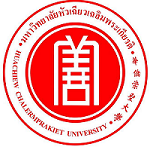Please use this identifier to cite or link to this item:
https://has.hcu.ac.th/jspui/handle/123456789/339| Title: | 非语言交际在泰国幼儿汉语课堂教学的应用研究----以泰国DENLA幼儿园为例 |
| Other Titles: | การศึกษาวิจัยการประยุกต์ใช้การสื่อสารเชิงอวัจนภาษาในการเรียนการสอนภาษาจีนสำหรับนักเรียนไทยระดับอนุบาล : กรณีศึกษาโรงเรียนอนุบาลเด่นหล้า ประเทศไทย A Study on the Application of Non- Verbal Communication in Classroom Teaching of Chinese Language for Kindergarten in Thailand : A Case Study of Denla Kindergarten, Thailand |
| Authors: | Li, Zhiyan 李志艳 黄惠萍 Huang, Huiping Huachiew Chalermprakiet University. College of Chinese Studies |
| Keywords: | โรงเรียนอนุบาลเด่นหล้า Denla Kindergarten School 以泰国DENLA幼儿园 ภาษาจีน -- การศึกษาและการสอน 汉语 -- 学习和教学 ภาษาจีน -- การใช้ภาษา 汉语 -- 语言使用 ภาษาจีน -- ตำราสำหรับชนต่างชาติ 汉语 -- 对外教科书 การสื่อสารโดยไม่ใช้คำพูด ภาษาท่าทาง การศึกษาขั้นอนุบาล 无语言交流 手势语言 幼儿园教育 Chinese language -- Study and teaching -- Thailand Chinese language -- Study and teaching Nonverbal communication Denla Kindergarten School Chinese language -- Study and teaching -- Foreign speakers Chinese language -- Usage |
| Issue Date: | 2021 |
| Publisher: | Huachiew Chalermprakiet University |
| Abstract: | 摘要非语言交际在汉语教学中扮演着重要的角色, 现如今受到越来越多学者的重视, 它与语言交际相辅相成, 发挥着无可替代的作用. 本文着眼于幼儿汉语课堂的教学实践活动, 从非语言交际的体态语, 副语言, 客体语和环境语四个方面阐述幼儿汉语教师如何将非语言交际应用在课堂教学中, 总结出汉语教学中非语言交际的使用规律和策略技巧. 笔者在起稿本篇文章前, 采用访谈法针对二十名泰国幼儿园汉语教师的非语言交际使用可能性进行调研, 评估非语言交际在泰国幼儿园中的使用情况和效果. 结合笔者所在幼儿园的教学实践, 根据学生使用非语言交际理论的前后教学效果进行分析对比, 每月追踪记录学生学习效果, 期末汇编成绩单, 采用SPSS软件中的对照样本T检验以此试证非语言交际的使用效果. 本论文采用定性调研和定量数据分析, 力求数据准确, 检验结果科学具有服力. 最后得出结论, 教师在汉语教学中辅助使用非语言交际, 丰富了教学手段, 加强教师与学生之间的情感交流, 推动学生在轻松自然的氛围中学习汉语, 提高学生的课堂参与度, 调动积极性, 使得汉语教学的课堂生动活泼, 幼儿学生的汉语成绩得到了明显进步. 文末笔者结合泰国幼儿汉语教学中出现的问题提出切实可行的建议, 并针对非语言交际与汉语教学相结合, 提出使用规范化的应用策略. Non-verbal communication plays an important role in teaching Chinese language, and it has increasingly received more attention from academics. Non-verbal communication does complement verbal language; somehow, both roles are irreplaceable. This article focuses on practical activities in classroom teaching of Chinese language for kindergarten. It explains how the teachers of Chinese language for kindergarten will apply the four areas of non-verbal communication: body language, paralanguage, artifacts, and environment in classroom teaching. It also summarizes the findings into rules and techniques for the use of non-verbal communication strategies in teaching Chinese language. Before drafting this paper, the researcher had surveyed the possibility of using the non-verbal communication by interviewing 12 Chinese teachers for kindergarten in Thailand and assessing the situation and the efficiency of using such communication in kindergartens in Thailand. The information obtained was combined with classroom teaching in the kindergarten that the author was teaching. The pre and post classroom assessments were analyzed to compare the efficiency of using non-verbal communication theory in classroom teaching of Chinese language for kindergarten by keeping the track records of student achievement every month and collecting the transcripts at the end of the semester to test the hypothesis. Then, the paired samples T test was run in the SPSS program to prove the efficiency of non-verbal communication in Chinese classroom teaching for kindergarten. The research utilized both qualitative research and quantitative analysis in order to obtain the accurate values so that the test results were scientifically proven and reliable. It is found from this study that the use of non-verbal communication of the teacher to teach Chinese language allowed teaching methods to be more diverse, strengthened the emotional communication between teachers and students, encouraged students to learn Chinese in a more relaxed and friendly atmosphere, increased student participation in class, and aroused enthusiasm in learning making Chinese language classes more fun and livelier. The academic results of the students in Chinese classroom also improved significantly. At the end of the article, the author offers realistic recommendations about the problems encountered in the teaching and learning Chinese for kindergarten in Thailand and proposes to use the standardized applied strategy by integrating non-verbal communication into teaching of Chinese for kindergarten. |
| Description: | Thesis (M.A.) (Teaching Chinese) -- Huachiew Chalermprakiet University, 2021 |
| URI: | https://has.hcu.ac.th/jspui/handle/123456789/339 |
| Appears in Collections: | College Of Chinese Studies - Theses |
Files in This Item:
| File | Description | Size | Format | |
|---|---|---|---|---|
| HUANG-HUIPING.pdf Restricted Access | 2.58 MB | Adobe PDF | View/Open Request a copy |
Items in DSpace are protected by copyright, with all rights reserved, unless otherwise indicated.
